Ukrainian holidays are a reflection of Ukrainian’s recent political history and shifting identity. They feature a range of secular and religious holidays. Some holidays have been celebrated for thousands of years and some, particularly patriotic and Western-influenced holidays, have been recently added to the line up. See below for descriptions of these Ukrainian holidays, their days off, and histories.
NOTE: Due to martial law in Ukraine, all national holidays have been suspended until further notice. We have listed below what would be their normal dates off, however, until the resolution of the current war, government offices will remain open and businesses have no obligation to close on these days. The holidays may still be privately observed.
Days Off
Long Weekends and Extra Days Off by Semester in 2025
NOTE: Due to martial law in Ukraine, all national holidays have been suspended until further notice. We have listed below what would be their normal dates off, however, until the resolution of the current war, government offices will remain open and businesses have no obligation to close on these days. The holidays may still be privately observed.
| Spring | Summer | Fall | Winter |
| March 8 May 1, 8 |
June 28 August 24 |
October 1 | December 25 January 1 |
New Year
In Ukrainian: Новий Рiк
January 1, 2025
Public holiday
(days off: Jan 1, 2025)
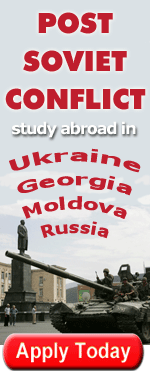 New Year’s, celebrated on the night of December 31-January 1st, is a massive holiday in Ukraine filled with merrymaking. On December 31, many Ukrainian cities host parties in the streets, complete with New Year’s trees (akin to Christmas Trees in the west) and fireworks. Also like Christmas in the West, Ukrainian New Year is associated with Santa Claus type characters and holiday feelings of optimism and generosity. The Ukrainains have both Sviatyij Mykolai, or St. Nicholas, a version more common in western Ukraine, and Did Moroz, or Grandfather Frost, a version more common in the east. Both are associated with gift giving and children.
New Year’s, celebrated on the night of December 31-January 1st, is a massive holiday in Ukraine filled with merrymaking. On December 31, many Ukrainian cities host parties in the streets, complete with New Year’s trees (akin to Christmas Trees in the west) and fireworks. Also like Christmas in the West, Ukrainian New Year is associated with Santa Claus type characters and holiday feelings of optimism and generosity. The Ukrainains have both Sviatyij Mykolai, or St. Nicholas, a version more common in western Ukraine, and Did Moroz, or Grandfather Frost, a version more common in the east. Both are associated with gift giving and children.
The most important part of the holiday is gathering with loved ones to feast and celebrate. Most often this is done at home, although bars and restaurants will also host their own New Year parties, and all major squares in the country will be full of Ukrainians celebrating outside as well. For the feast, Olivier and Herring Under a Fur Coat salads are common on the holiday table. If at home, Ukrainians typically leave the TV on throughout the celebrations, tuned to one of several holiday variety shows that air that night or to classic movies, which helps provide atmosphere but which are rarely attentively watched. At midnight however, there is a televised presidential address to the nation, which has been tradition since Soviet times, and is attentively watched by most. After the address, people make champagne toasts and often go outside to watch or light off fireworks.
As of 2020, 74% of Ukrainians consider New Year to be a favorite/most important holiday in a poll that allowed respondents to pick multiple holidays as “most important.”
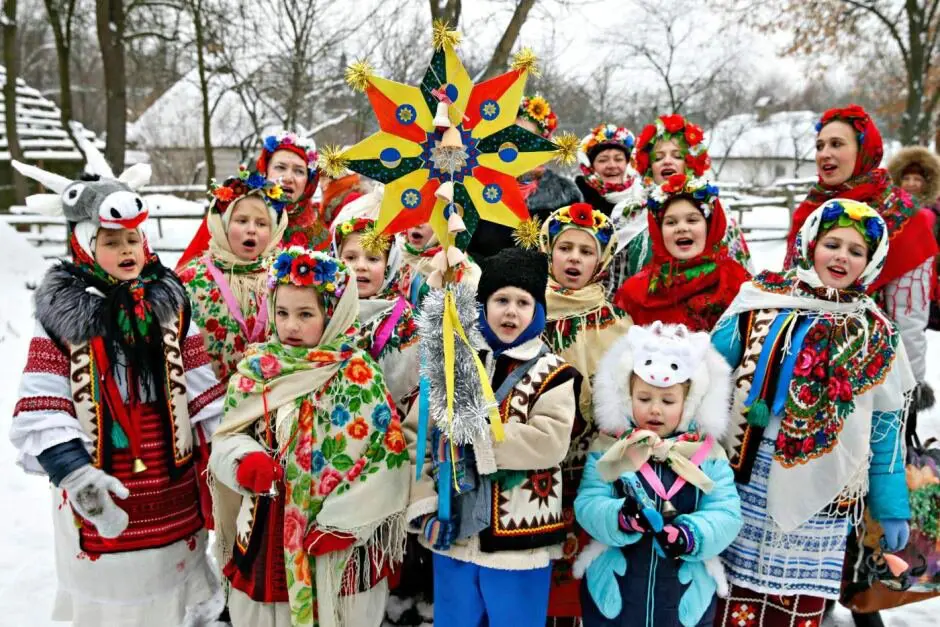
Old New Year and Malanka
in Ukrainian: Старий Новий рік і Маланка
January 13-14, 2025
(Informal holiday, no day off)
When the Communists adopted the Georgian calendar in 1919, making Russian dates standard with most of the rest of the world at the time, the Orthodox Church refused to accept the transition. To this day, Orthodoxy calibrates its holidays to the Julian calendar. The current discrepancy between the two measures 13 days, gaining 11 minutes and 14 seconds per year. Thus, eventually the date will move again. Although New Year is not a religious holiday, many people throughout the former Soviet space use the dual calendars to celebrate the New Year an extra (although more subdued) time.
Old New Year’s Eve also coincides with Malanka, a Slavic folk holiday that celebrates the coming spring. Another name of the holiday in Ukrainian is Щедрий Вечір – or “The Generous Night.” Many Ukrainians hold the superstition that serving a specific variety of food on this date will correlate with prosperity in the New Year. Pork symbolizes abundance while fish signals the opposite, for instance. People go caroling at night and perform skits and dances. Traditionally, a man plays the role of the female Malanka and wears women’s clothing. In the early morning of New Year’s Day, young men sow seeds to bring happiness to the house in the coming year.
While more muted than the raucous celebrations on December 31, Old New Year and Malanka are quite broadly celebrated by Ukrainians, especially by observant Orthodox believers. In recent years, these performances have taken on political dimensions and carry messages of civic and cultural unity for Ukrainians.
Ukrainian Unity Day
in Ukrainian: День Соборностi України
January 22, 2025
Public holiday, day off
(Day off: January 22, 2025)
Ukrainian Unity Day commemorates the 1919 Unification Act (Act Zluky). Out of the “graveyard of empires” created by World War I, two Ukrainian states emerged: the Ukrainian People’s Republic (UPR) and the West Ukrainian People’s Republic (WUPR). The UPR formed in 1917, initially as an autonomous region of Russia, following the February Revolution. Meanwhile, the WUPR was comprised of former Austro-Hungarian lands. Both declared independence in 1918 and unified under Act Zluky on January 22, 1919. This act was primarily symbolic as both new states retained independent armies, bureaucracies, and governmental structures. The dream of a united, independent Ukraine was short-lived and most of both states were subsumed by the Soviet Ukrainian SSR in 1922.
In 1990, a pro-democracy party known as “People’s Arm” organized a massive demonstration to mark the 71st anniversary of Act Zluky. Ukrainians formed a 700-km human chain that stretched from Ivano-Frankivsk to Lviv to Zhytomry to Kyiv. According to Soviet estimates, 450,000 people participated. Unofficial estimates place the number much higher. The organizing political party won a quarter of seats in parliament that year and helped push the country towards independence. The day was made a state holiday in 1999 and is often commemorated with human chains. This year, Ukrainians formed a human chain across the Dnieper River, symbolically marking the unity of Ukraine and solidarity against aggression.
Masliana
in Ukrainian: Масляна
February 24 – March 2, 2025
(Variable dates, unofficial holiday, no days off)
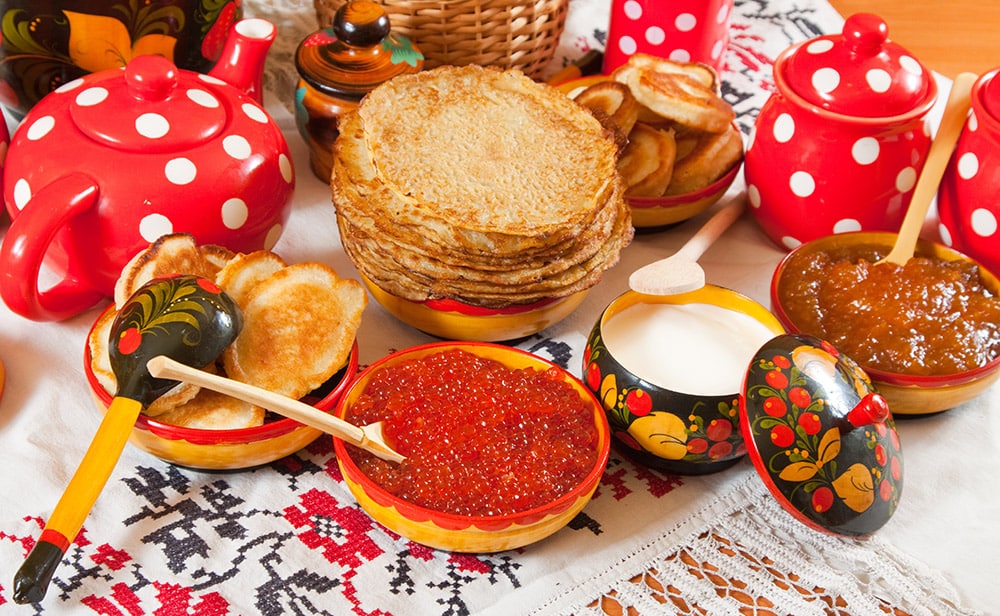
Masliana (known in Russian as “Maslenitsa“) is an ancient Slavic holiday that has recently been marked by a mass baking of flat pancakes called, in Ukrainian, mlyntsi. Looking further back in time, however, varenyky stuffed with farmer’s cheese were more common in Ukraine. Some Ukrainians are moving back to varenyky now as the association with mlyntsi developed under the Russian Empire and the USSR.
In pagan tradition, Masliana marks the end of winter. The mlyntsi themselves resemble the sun and, as part of the celebrations, an effigy of winter is burned, symbolizing rebirth and the coming spring. The varenyky, meanwhile, are viewed as symbols of the womb and therefore also of birth and fertility. Masliana took its present name and place in the calendar when the Kyivan Rus adopted Orthodox Christianity. In the week prior to Lent, Eastern Orthodox Christians don’t eat meat. Mlyntsi and varenyky with cheese are vegetarian, and so can be consumed freely during pre-Lent time.
Ukrainians celebrate Masliana with enthusiasm with many of the same traditions common to both Russians and Belarusians, enjoying sledding, snowball fights, and copious consumption of mlintsi. Societal norms are more fluid during Masliana – wearing masks and clothing designed for other genders is permitted. Horseback riding, live music, and a variety of folk performances enliven the holiday. Mlyntsi are found in restaurants everywhere and served by vendors in the streets as well. Find out more about Masliana and similar celebrations across the post-Soviet space here.
International Women’s Day
in Ukrainian: Міжнародний Жіночий День
March 8, 2025
Public holiday, day off
(Day off: March 8, 2025)
On International Women’s Day, men are expected to go out of their way to appreciate the women in their lives. Women are given gifts, food, and flowers (odd numbers of stems, of course – gifting an even number of stems is reserved for funerals). Ukrainians have the day off, and women are supposed to relax and bathe in compliments and kind acts. In the run-up to the day off, workplaces often bring in food, champagne, flowers, and more.
In recent years, the day has turned into a day for feminist protests for equal rights and ratification of the Istanbul Convention, which aims to reduce violence against women. These protestors argue that the day should be turned from one of simply appreciation to a day to advocate for equal rights and expanded opportunities. Read more about the history of this day in this Russian MiniLesson. To see what SRAS students have observed of this holiday, click here.
Easter
in Ukrainian: Пасха; Великдень
April 20, 2025
Variable dates, public holiday, the Monday after Easter Sunday is a day off
(Day off: April 20, 2025)
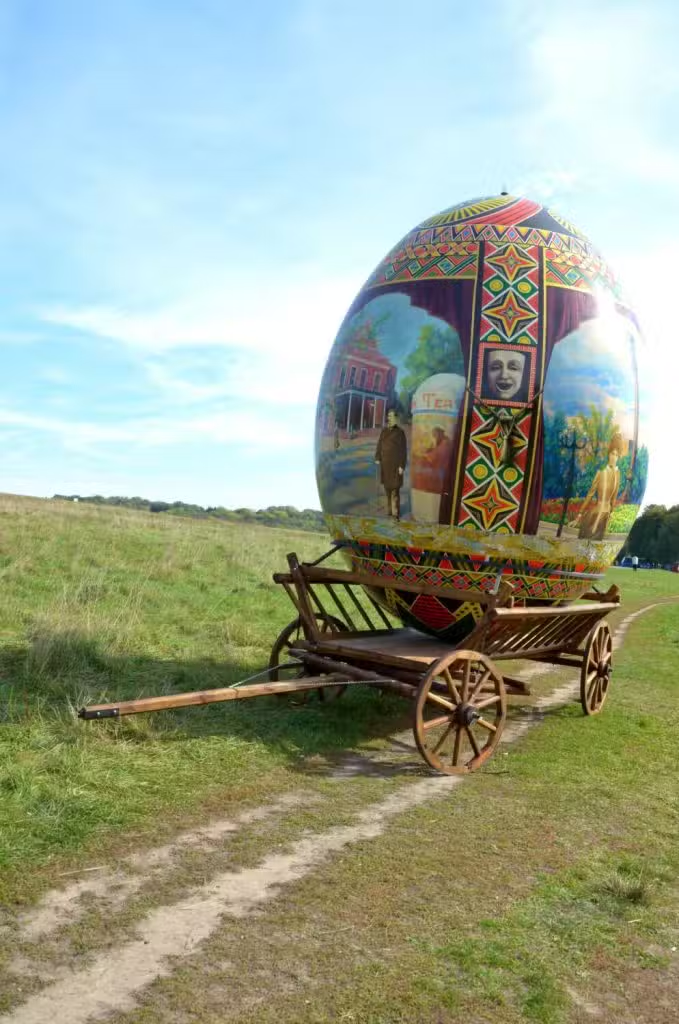
Easter for both Orthodox and Catholic/Protestant cultures is celebrated on the first Sunday after the first full moon on or after the vernal equinox. Because the to cultures use different calendars, however, the “first Sunday” often falls on a different date.
Easter is a huge deal in Ukraine. In fact, one of the names for the holiday is “Великдень” – which translates roughly to “The Great Day.”
About two-thirds of Ukrainians identify as some branch of Orthodox. Easter marks the end of Lent, so meat and dairy dishes are abundant. Traditionally, the devout don’t sleep the night before Easter. They go to their local Orthodox church for a service followed by a feast that lasts until morning.
In the East Slavic countries, Easter can not be imagined without its two main foods – colored eggs and a kulich, which is a sweetened, decorated bread made in a tall cylindrical mold. As for the eggs, two forms of them eggs are traditionally made in Ukraine: pysanka and krashenka. Pysanka are the iconic decorated eggs known world-over, hand painted with intricate designs; krashenka are dyed eggs. Most commonly, onion skins are used to dye them red to symbolize the blood of Jesus. Both eggs and kulich can have the letters “ХВ” written on them, which stand for a phrase “Христос воскрес” (Christ is risen). The phrase is used as an Easter greeting, usually answered with “Воістину воскрес!” (He is risen indeed).
As of 2020, 77% of Ukrainians consider Easter to be a favorite/most important holiday in a poll that allowed respondents to pick multiple holidays as “most important.” Thus, Easter completes what can be considered a sort of trinity of most important holidays in Ukraine, along with the New Year and Orthodox Christmas.
Pentecost
in Ukrainian: П’ятдесятниця
June 8, 2025
Variable days, public holiday
(Day off: June 8, 2025)
In Orthodox Christianity, Pentecost Monday is the day that the Holy Spirit appeared to the Apostles. A great feast, whose religious importance is secondary only to Easter occurs on Pentecost Sunday. Echoing a similar Jewish holiday, some religiously observant Ukrainians decorate their houses with plants and greenery and then visit cemeteries and leave food for deceased relatives. These Jewish traditions hybridized with the Eastern Orthodox religious holiday to form a uniquely Ukrainian holiday. Although widely celebrated, it was named as “most important” by only 31% of Ukrainians in 2020.
Labor Day
in Ukrainian: День праці
May 1, 2025
Public holiday
(days off: May 1, 2025)
Known as “Day of International Solidarity of Workers” when it was founded under the USSR, Ukraine officially changed the holiday’s name to “Labor Day” in 2017. Elsewhere in Europe, far-left political parties organize protests and demonstrations on International Worker’s Day. Ukraine has recently undergone a massive “decommunization,” however, and this seems to have subdued most radical left demonstrations. Yet, compared to other European countries, labor protections are relatively weak in Ukraine. After the communist era, trade unions largely lost power. Leaders of independent trade unions risk losing their jobs.
For most, International Worker’s Day is merely a welcome day off. As the weather warms, many Ukrainian families spend the day outside, often grilling shashlik. Labor Day also marks the beginning of dacha season. Many people take the opportunity to clean and begin spring dacha planting.
Day of Remembrance and Victory over Nazism in World War II 1939-1945
in Ukrainian: День па́м’яті та перемо́ги над наци́змом у Дру́гій світові́й війні́ 1939 – 1945 ро́кі́в
May 8, 2025
Public holiday
(days off: May 8, 2025)
 In 2014, as part of broader decommunization efforts, Ukraine changed the official name for the former Soviet holiday known as “The Day of Victory in the Great Patriotic War” to “The Day of Victory over Nazism in World War II.” The same legislation also began to refer to the war in general not by the Soviet name (Great Patriotic War) but by the European name of “World War II.” The holiday itself remained celebrated much the same, however, on May 9th, with displays of patriotism, and occasionally military parades.
In 2014, as part of broader decommunization efforts, Ukraine changed the official name for the former Soviet holiday known as “The Day of Victory in the Great Patriotic War” to “The Day of Victory over Nazism in World War II.” The same legislation also began to refer to the war in general not by the Soviet name (Great Patriotic War) but by the European name of “World War II.” The holiday itself remained celebrated much the same, however, on May 9th, with displays of patriotism, and occasionally military parades.
Ukraine made further legislative adjustments to the holiday in 2022 following the start of its war with Russia. The date of the holiday was moved to May 8, in line with most European celebrations and the full name was changed to “Day of Remembrance and Victory over Nazism in World War II 1939-1945” – adding the dates to further distance it from the Russian equivelant. WWII began in Europe in 1939 while the Great Patriotic War refers the War the USSR fought from 1941-1945.
Ukraine’s celebrations are now marked with the European red poppy as an official symbol. Celebrations are also comparitively muted, no military parades are held, although smaller military band performances can sometimes be seen. Fireworks were also once common, but major city displays are no longer part of the official celebrations. The savings are used for larger state bonuses paid to veterans. Events are also held to honor those that died in the recent Maidan Revolution and military conflicts in Donbass.
This holiday was named as a “most important” holiday only by 33% of Ukrainians in 2020.
See more about how Victory Day is celebrated across the Post Soviet space here.
Europe Day
in Ukrainian: День Європи
May 9, 2025
(Variable days, state holiday, no day off)
Europe Day was first celebrated in Ukraine in 2003 to demonstrate the country’s commitment to European unity. The European Union observes Europe Day on May 9. Initially, Ukraine celebrated its Europe Day on the third Saturday of May to avoid overlapping with Victory Day celebrations. In 2023, President Volodymyr Zelenskyy decreed that Ukraine would align its Europe Day with the EU, celebrating on May 9. This change reflects Ukraine’s ongoing efforts to integrate more closely with the European Union. While Europe Day is not a public holiday in Ukraine, various events are organized to promote European values and culture and the day serves as an opportunity for political leaders to advocate for closer integration with the EU.
Vyshyvanka Day
in Ukrainian: День вишиванки
May 15, 2025
(Variable day, unofficial holiday, no days off)

The vyshyvanka is a traditional Ukrainian embroidered shirt. They have been gaining in popularity for several years and can often be seen on the streets of Ukraine, often worn with blue jeans as casual attire. Vyshyvanka Day started in 2006 as a flashmob at Chernivtsi National University. It has since grown into a national and even international event, even earning a Google doodle in 2020. The day is celebrated on the third Thursday of May by simply wearing a vyshyvanka and serves as a reminder of Ukraine’s unique identity and traditions and encourages feelings of unity.
Constitution Day
in Ukrainian: День Конституції
June 28, 2025
Public holiday
(days off: June 28, 2025)
On June 28, 1996, the Ukrainian Constitution was adopted by the Verkhovna Rada (Ukrainian Parliament). Ukraine had operated without a constitution after independence for five years. It was, in fact, the last post-Soviet state to adopt a constitution.
Although Constitution Day has taken on special meaning since the war began in Donbas, growing increasingly to mark a symbolic celebration of Ukraine’s sovereignty and territorial integrity, a majority of Ukrainians still treat the day mostly as just a day off. Just 7% of Ukrainians named it as a “most important holiday” in 2020 (although the percentage has grown somewhat since 2013, when 4% said the same thing). The day is celebrated with fireworks, parades, educational/patriotic events for the youth and musical performances.
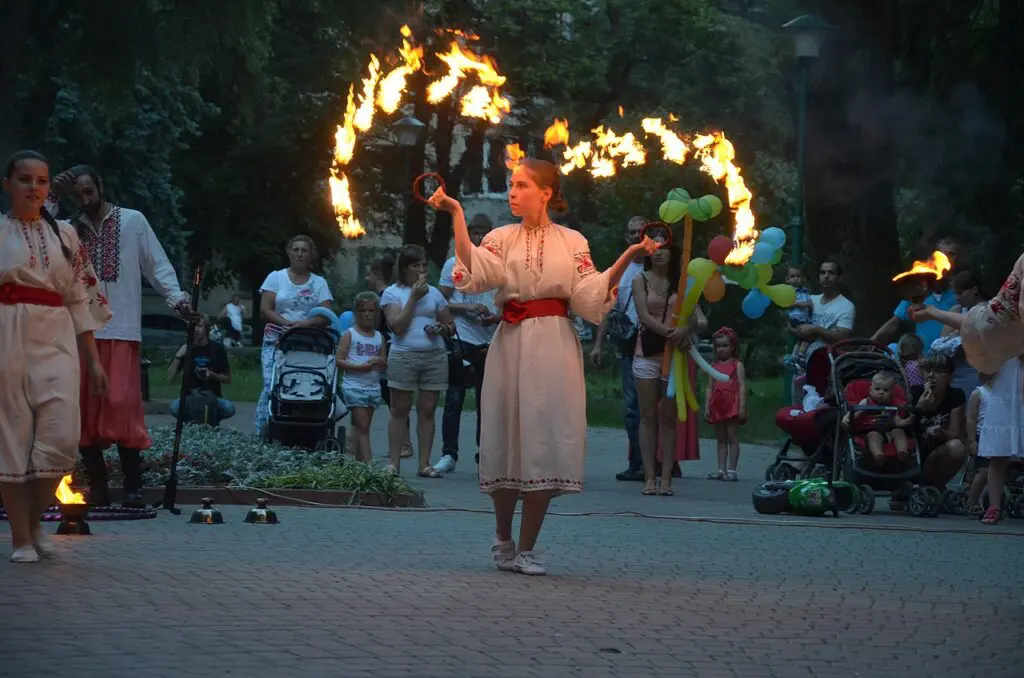
Kupala
in Ukrainian: Купала; Івана Купала
June 23, 2025
(Unofficial holiday, no day off)
Kupala is an ancient pagan holiday celebrated across much of the Slavic pagan world, but which is especially popular in Ukraine. First mentioned in writing in the 11th century, it likely originated far earlier. A pot found from the 4th century has an inscription that seems to mark the date of Kupala, for instance.
The holiday is also known as “Ivan Kupala.” The “Ivan” part may have been added when the Orthodox Church attempted to incorporate the holiday, making it part of celebrations for John the Baptist. With the “Ivan” added, the day’s name translates to “John the Bather.” However, the original part refers to Kupalo, the Slavic god of love and the harvest.
The holiday is celebrated with the elements – particularly water and fire. People float flowers down rivers to divine romantic futures. Couples jump into the water holding hands; those who separate before submerging are said to be headed for rocky waters. People also jump over bonfires laden with holy-water-blessed herbs to demonstrate strength, faith, and vitality.
Another tradition is looking for a “fern flower” which is said to only appear on the night of Kupala, and which legend holds will bring the finder power and good luck. People search forests for the elusive good luck charm (despite knowing that ferns don’t flower).
Like Maslenitsa and Malanka, Kupala has proved remarkably resilient against attempts to Christianize the holiday. It is a holiday associated with nature and not celebrated much inside the cities. However, celebrations in the countryside are always surprisingly plentiful. It traditionally marks the beginning of the harvest and is a joyful, lively holiday in Ukraine. For more about this holiday and other Slavic midsummer festivals, click here.
Independence Day
in Ukrainian: День Незалежностi
August 24, 2025
Public holiday, day off
(Day off: August 24, 2025)
Ukrainian Independence Day marks the day that Ukraine declared independence from the USSR in 1991 after holding a referendum in which over 90% of voters approved independence, including majorities in Crimea and Donbass. In previous years, the holiday featured large military parades. President Zelensky, however, has forgone most military parades and instead uses the event budget to award bonuses to Ukrainian soldiers. People killed in battle and in the Euromaidan Revolution are quietly honored at memorials. Aside from state-sanctioned festivities, Ukrainians attend outdoor concerts, parties, and reenactments of Kyivan Rus traditions. Vyshyvankas, Ukrainian flags, and the Ukrainian coat of arms are all commonly seen on this day.
Defender of Ukraine Day
in Ukrainian: День захисника України
October 1, 2025
Public holiday
(Day off: October 1, 2025)
Like Victory Day, the Defender of Ukraine Day changed its name in 2014, replacing the Soviet-era holiday Defenders of the Fatherland Day. It also changed its date, moving from February 23rd, the day the Red Army was officially formed, to October 14th, with revives a much older Ukrainian Cossack tradition of celebrating military valor on the Orthodox holiday of the Intercession of the Theotokos. Theotokos is the Virgin Mary, who the Cossacks took as their patron saint. The day also marks the official founding of the Ukrainian Insurgent Army (UIA) from WWII, which was Nazi in its ideology. Today, some ultra-nationalist and right-wing groups have taken this as a reason to co-opt the holiday to hold rallies. The day has also become a day to mobilize “anti-capitulation” protests opposing any resolution to the Donbass conflict that could be seen in a way as friendly to Russian interests. Outside of protests, the holiday is marked by patriotic art exhibits, prayer services, and concerts. 10% of Ukrainians named it as a “most important holiday” in 2020.
Liberation of Ukraine Day
in Ukrainian: День визволення України
October 28, 2025
(Public holiday, not a day off)
This day marks the day that Soviet forces expelled the last German troops from Ukrainian territory. People honor veterans and lay flowers on graves on this day. The president of Ukraine usually lays flowers on the Tomb of the Unknown Soldier in a remembrance ceremony.
Museums host exhibitions on World War II. However, the day is generally muted, and in 2022 it hasn’t been made a day off. Some have also suggested that, as with other holidays, the name of the holiday should be changed, as “liberation” implies a freedom and independence, which protestors feel Ukraine did not enjoy until the fall of the Soviet Union.
Dignity and Freedom Day
in Ukrainian: День гiдностi та Свободи
November 21, 2025
(State holiday, no day off)
 Dignity and Freedom Day honors the Orange Revolution of 2004 and the Revolution of Dignity of 2013. In the Orange Revolution, protesters demanded and received a re-vote in an election they said was marred with corruption and fraud. The Euromaidan movement began in protest to ex-President Yanukovych’s decision to stall the Association Agreement with the European Union. Following violence, the movement escalated and eventually demanded and received Yanukovych’s removal.
Dignity and Freedom Day honors the Orange Revolution of 2004 and the Revolution of Dignity of 2013. In the Orange Revolution, protesters demanded and received a re-vote in an election they said was marred with corruption and fraud. The Euromaidan movement began in protest to ex-President Yanukovych’s decision to stall the Association Agreement with the European Union. Following violence, the movement escalated and eventually demanded and received Yanukovych’s removal.
Dignity and Freedom Day celebrates Ukraine’s aspirations towards good governance, resilient democracy, and sovereignty. Parades and events commemorating the revolutions and remembering the people who died in the Euromaidan protests are held throughout the country, with the largest occurring in Kyiv and Lviv. In previous years, museums have hosted exhibits and cultural organizations have created street displays about the two revolutions. Churches hold memorial services and candle lightings for the “Heavenly Hundred,” the moniker for the protestors killed by snipers during that revolution. The Euromaidan Revolution is a point of pride and pain in the recent memory for many Ukrainians. Similar to Victory Day, Dignity and Freedom Day provides people the opportunity to mourn the dead and celebrate what victory achieved.
St. Nicholas Day
in Ukrainian: День Cвятого Миколая
December 6, 2025
(Unofficial holiday, no day off)
Predominantly celebrated in Western Ukraine, which shares many cultural ties to traditionally-Catholic Poland, St. Nicholas Day kicks off the winter holiday season. Rather than exchanging gifts on Christmas, gift-giving largely occurs on St. Nicholas Day. The day is particularly anticipated by children, who write letters to St. Nicholas with specific requests. Many people also give to charity on St. Nicholas Day, especially to organizations that help orphaned and low-income children. St. Nicholas Day has a lively air as people gear up for the season of winter Orthodox holy holidays.
Christmas
in Ukrainian: Рiздвянi
December 25, 2025
Public holiday
(days off: December 25, 2025)
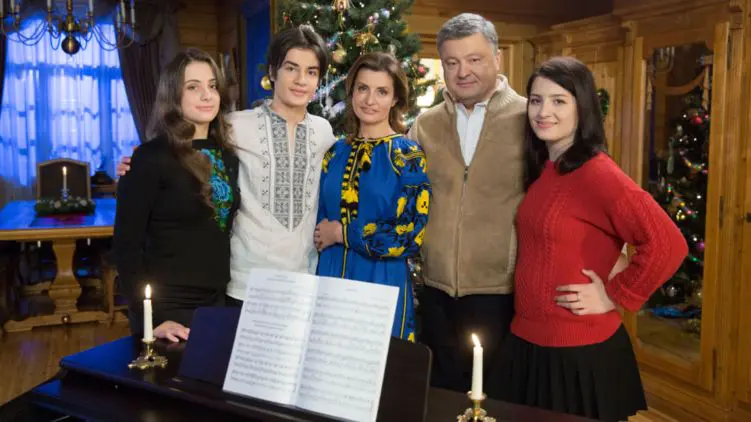
Most Orthodox faiths celebrate Christmas by the Julian calendar, for which Dec 25 currently aligns with January 7 on the Georgian calendar, which is used by almost all state governments. This is because, when the Communists declared that the soviets would adopted the Gregorian calendar, the Russian Orthodox Church dissented and kept the Julian as the church calendar.
Most Orthodox churches in Ukraine also followed the Julian calendar until September, 2023, when the Orthodox Church of Ukraine and the Greek Catholic church declared they would both switch to the Gregorian calendar. At the same time, Ukraine adopted a law officially cancelling January 7 as a state holiday, proclaiming that it was distancing itself from Russian imposed traditions.
From 2017-2023, Ukraine officially recognized two Christmases. About 10% of the population is Latin Catholic (0.8%), Unspecified Christian (7.7%), or Protestant (2.2%) and thus more likely to celebrate “Western Christmas.” Thus, December 25th was made a national holiday in 2017, effectively giving Ukraine two official Christmases and signifying Ukraine’s commitment to recognizing and protecting religious pluralism. However, this addition to the calendar at the time was quite controversial.
Most Catholics and Protestants in Ukraine are concentrated in the western half of the country, so celebrations were more common there. Lviv hosts a Christmas fair in early December with lights, ice skating, vendors, and, of course, mulled wine. For most of the rest of the country, December 25 passed as just a day off without public observance. According to a poll by Research & Branding Group showed that the “New” Christmas was celebrated by 18% of the respondents in 2017, indicating that the holiday was likely being celebrated by Orthodox Ukrainians whose church at the time still recognized January 7th as the official date.
While December 25 has yet to be officially celebrated under the new system, it is likely that traditions will be kept from the old system. Christmas has always been a strictly religious holiday in Ukraine. Some observant Ukrainians fast all day on Christmas Eve (known in Ukrainian as Свята Вечеря – The Holy Eve), drinking only holy water. The fast is broken only when the first star in the sky appears, at which time, a feast begins. Twelve (often vegan) courses are served to represent the twelve disciples. The dining room has a didukh placed in it, which is a sheaf of wheat representing one’s ancestors’ presence and the family’s continued prosperity. After dinner, carolers dress in traditional clothing and parade with papier-mâché stars. Many attend a Christmas Eve church service. Other traditions vary by region. In some areas, people paint Christmas eggs similar to the iconic Ukrainian Easter eggs (see below). Other places, particularly in rural areas, a theatrical contest between villagers and people dressed as monsters occurs, reminiscent of pagan rituals.
As of 2020, 79% of Ukrainians considered Christmas (then celebrated on January 7) to be a favorite/most important holiday in a poll that allowed respondents to pick multiple holidays as “most important.” Thus, Christmas slightly outranks New Years in importance, although not by much.
More About Ukrainian Culture
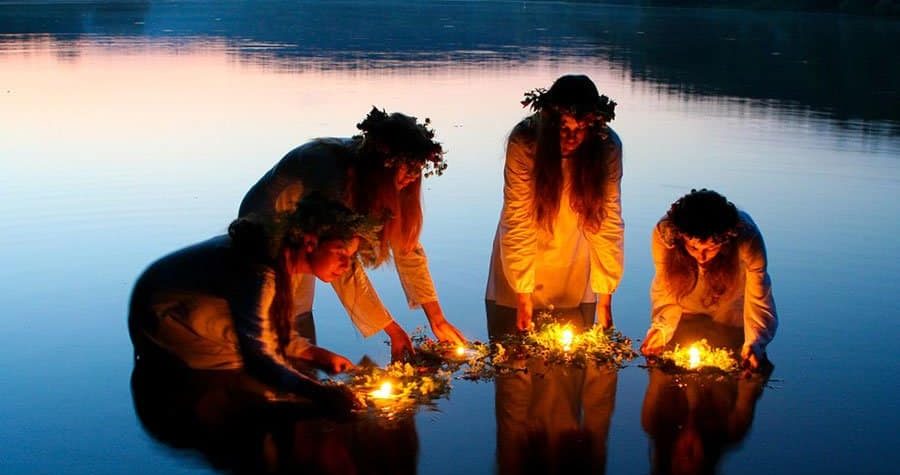
Kupala: Ancient Slavic Midsummer Mythology and its Modern Celebration
Kupala is an ancient Slavic holiday celebrating the summer solstice, or midsummer. Once part of a series of annual rituals, it marked and was believed to sustain agricultural cycles—essential to early human survival. Held as vitally important, these pagan traditions remained deeply rooted even after Christianization, technological change, and centuries of oppression tried to dislodge […]

Kulich, Paska, Nazuki: The Easter Breads of Eastern Christianity
Easter breads such as kulich, paska, choreg, and nazuki are delicious Easter traditions. Easter is by far the most important religious holiday for those practicing Eastern Christianity. In addition to church services and egg dying, the holiday is also marked across the cultures by ritual bread baking. Despite the wide geographic area covered by Eastern […]
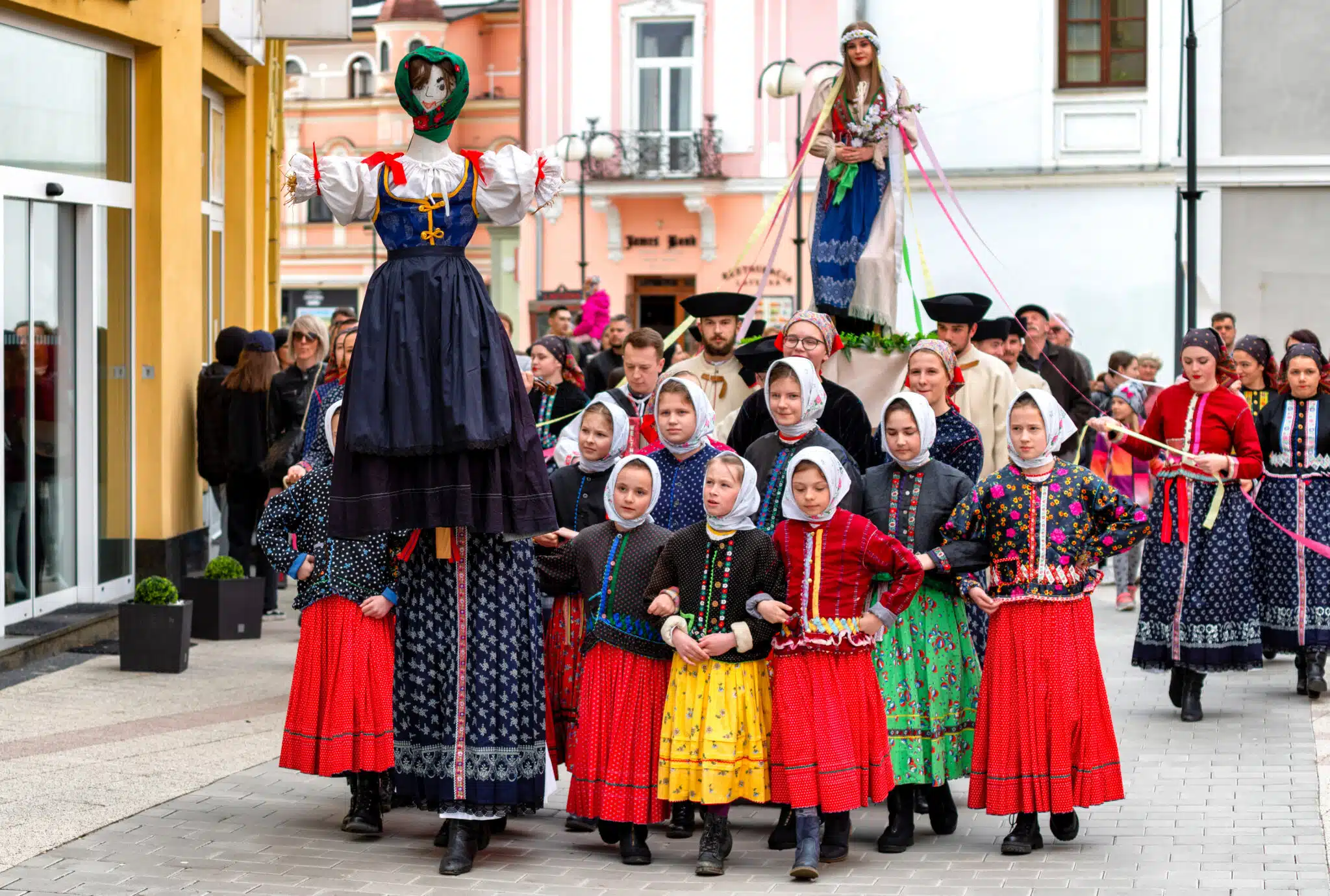
Maslenitsa, Masliana, Meteņi: Spring Holidays of the Slavs and Balts
Rites of welcoming spring and saying goodbye to winter are some of the oldest holidays preserved across Slavic cultures. In the Baltics, the celebrations were nearly lost after being suppressed by Catholic and imperial dominance. Today, Russia’s Maslenitsa is by the far the best-known, but multiple versions exist across the diverse Slavic landscape. In the […]
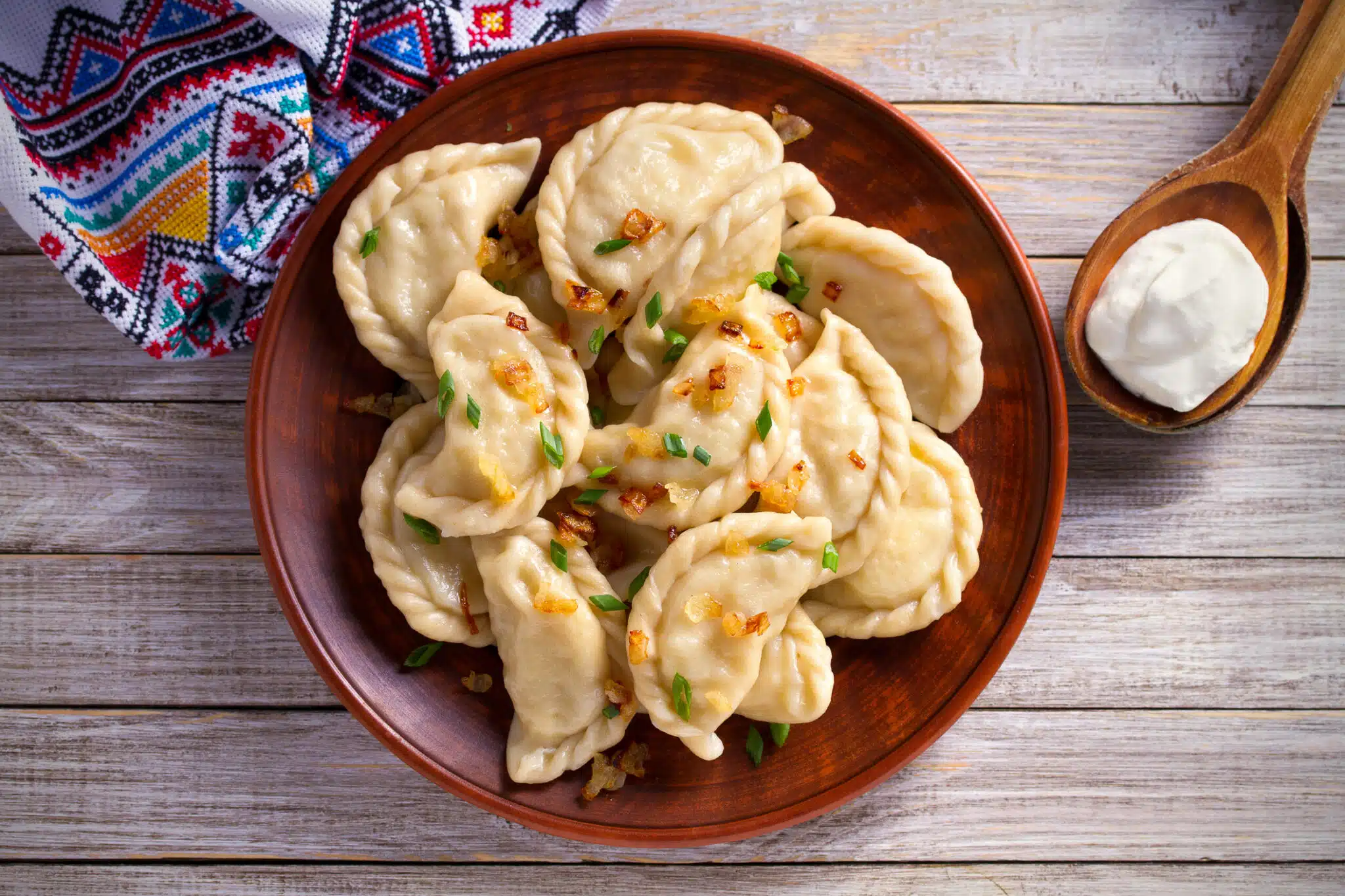
Pierogi, Pīrāgi, Varenyky: A Tour of Pastries and Dumplings
The dumplings and pastries of Europe’s northeastern flank have a story to tell. Their recipes, etymologies, and related traditions are intertwined in a complex historical knot. There are so many ancient connections that it is almost impossible to say which influenced the next. And yet, each dish is held up as a unique and integral […]

Olivier and Rasols Salads: Holiday Traditions With Fascinating Histories
Russia’s Olivier Salad (Салат «Оливье») and Latvia’s rasols are well-known staples of their respective cuisines and common additions to holiday tables. Today, the recipes for both are quite similar, with chopped vegetables, egg, and meat dressed with mayonnaise. Olivier is now eaten throughout the former USSR and has even become common as “Russian Salad” in […]





